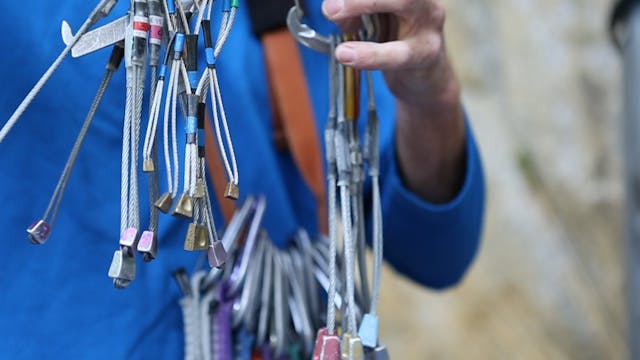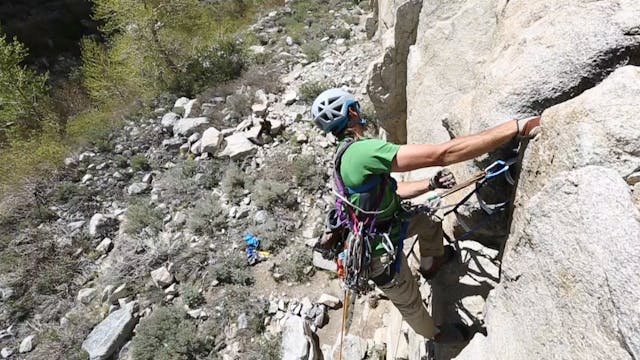Aid Climbing: 11. Racking for Aid Lead - Part 1 of 2
Aid Climbing & Big Walls
•
6m 19s
Racking up for an aid climb or a big wall route is no small task. In this video, we look at all the technical climbing gear that goes into climbing, cleaning, and hauling on a big wall. In general the quantity of any particular gear you’ll bring with you will depend on the route (check topo), as well as personal preference and climbing abilities.
- Shoulder Slings & Quickdraws - We recommend bringing a combination of shoulder slings and quickdraws up to a total of 20. Favor shoulder slings over quickdraws (i.e. 13/7) since slings are more versatile (they can be looped around horns and flakes as protection, as well as extend cams and stoppers placed on lead).
- Cams (Regular and Offset) - As many as the route requires. This could include a triple set of finger size to very large cams depending on the route. Note we recommend using Alien for the small cams since they fit well in small cracks, have flexible stems, and also make an “offset” cam which is mandatory for any big multi day.
- Stoppers / Nuts - A good mix of small “offset” as well as large regularly shaped stoppers (i.e. nuts). Ideally some brass stopper heads, as these are a little softer than the rock and provide a slightly better purchase than aluminum stoppers. The head of the nut is brass or aluminum, while the cable on either style is made of steel.
- Hauling Device - We recommend the Petzl Pro Traxion which has a progress-capturing ratchet.
- Swivel Piece - Allows the haul bag to rotate freely on the haul line so it doesn’t twist up your rope.
- Haul Line Knot Protector - Homemade device made from the top-half of a larger plastic soda bottle (e.g. litre or two-litre), reinforced with duct tape. This protects the knot on your haul bag from wear and tear, and helps prevent it from getting stuck in cracks or under roofs as you haul.
- Haul Line - Static rope used for hauling the haul bag.
- Free Carabiners - Several free carabiners to be used for clipping loose gear (i.e. food bags, sleeping bags...etc). We recommend using wire gate carabiners for weight reduction.
- Locking Carabiners - 3-5 extra locking carabiners.
- Cordelettes w/ Locking Carabiners - For anchors.
This will be used in addition to the gear covered in our videos on “General Aid Gear” and “Additional Aid Gear”.
We hope you found this video helpful. Feel free to comment below with questions or thoughts!
Please remember, climbing is inherently dangerous. Climb at your own risk.
Up Next in Aid Climbing & Big Walls
-
Aid Climbing: 12. Racking for Aid Lea...
In this video we continue to look at how to rack for leading aid climbs. Now that you know what gear you need, and you know how the process works, let’s consider where to put all that gear you’ll be using!
Be sure to review our video on “General Aid Gear.” The following guidelines are not the ...
-
Aid Climbing: 13. Leading Steep Terrain
Aid climbing poses a very different set of challenges to the follower when compared with traditional free climbing. In this video we discuss some key considerations for the leader in steep terrain, so they don’t make cleaning even more difficult for the follower.
When leading steep pitches, it...
-
Aid Climbing: 14. How to Pendulum Whi...
When leading on aid, you may find yourself at a dead-end crack, looking at a blank wall — where all rock features seem to disappear after a fixed pin, or bolt, or some other piece of fixed gear.
Then, out of the corner of your eye—or on the topo map stuffed into your pocket — you spy more feat...


